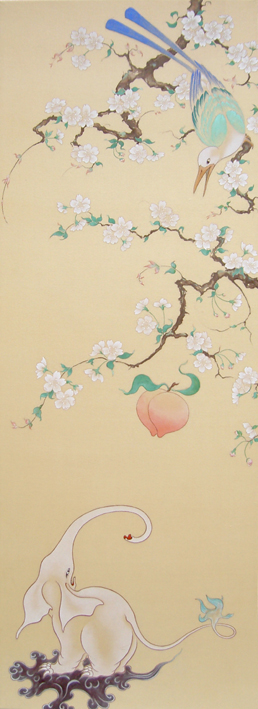Fri. 16 March - Sun. 15 April
Adam Booth ![]()
Eternal Spring
Japanese painting
Tokyo-based British artist Adam Booth will exhibit his newly painted works in Asakusa this Spring, which is a particularly special time during which the Japanese appreciate the scenery of nature. The central motifs of his work are peaches, white elephants and exotic birds. For this exhibition he has tried to keep a feeling of spring by using light color backgrounds and flowering cherry trees. The peaches, that appear falling, flying, or burning in his paintings are not ordinary peaches. In Asian cultures the peach is a symbol of longevity. In this respect it would seem to be a symbol of something that mankind desires, but that which is kept from him by the gods. In his work, the peaches have come to represent the desires in all of us for the things that we want in life, but find ourselves unable to achieve or obtain. The elephants of his paintings come in various sizes and shapes, sometimes transforming into almost unrecognizable figures that float down from the sky. By twisting and changing the shape and size of the elephant he wishes to question notions of reality and truth. The exotic birds are used in his work to create tension between the elephant and the peaches. They, like the elephants can be considered as auspicious signs, but at the same time they have a slightly sinister feel to them. He tries to create an air of uncertainty in the work that causes the viewer to question the intentions of the birds and elephants towards the peach. Adam chose the exhibition title "Eternal Spring" to represent the idea of a peaceful utopia, like the mythical Togenkyou. He wishes the viewer to consider whether this "Eternal Spring" utopia has to remain the product of our desire, that like the peaches is unobtainable, or if we can turn our own world into a peaceful utopia - a world of Eternal Spring.
|
 |
| opening performance | MON JEAUX | gypsy jazz music violin | Hiroyuki Ota accordion | Tadashi Harada guitar | Takamasa Miwa | Hiroyasu Hirano bass | Tomoaki Togawa |
|
